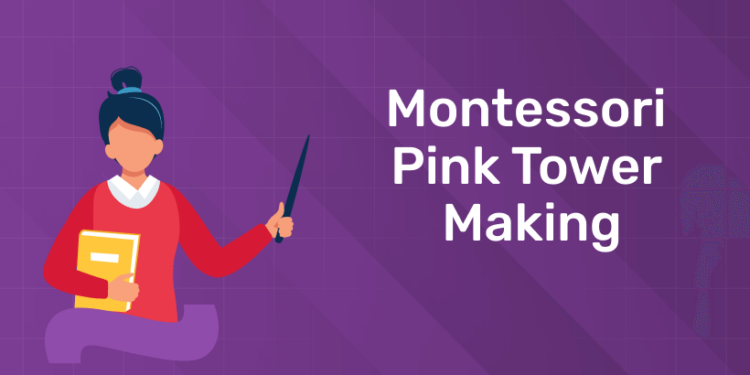Table of Contents
The Pink Tower is one of the most iconic Montessori materials used in preschool classrooms. It is a set of ten wooden blocks, ranging in size from 1cm to 10cm, all painted pink. The blocks are designed to help children develop visual and spatial awareness skills as well as the ability to discriminate between sizes.
What is a Pink Tower?
The Pink Tower is part of the Montessori Sensorial Program. Children are encouraged to explore the blocks by touching and looking, as well as arranging them from largest to smallest. In doing so, children develop their ability to recognize and differentiate sizes as well as their hand-eye coordination and concentration. The Pink Tower also serves to introduce mathematical concepts such as number sequences and the decimal system.
The Pink Tower blocks are made from natural wood and painted with non-toxic pink paint. Each block is a perfect cube, with smooth edges and corners. The smallest block in the box measures 1 cm³ and the largest 10 cm³. Each block is exactly ten times larger than the previous block. The blocks are arranged on the shelf, from largest to smallest.
Register for the Entri Elevate Montessori Teacher Training Program! Click here to join!
Why is it Pink?
1: What is the primary focus of the first plane of development in the Montessori method?
Each cube in the Pink Tower is painted pink to help children focus on the lesson at hand rather than the color of the cubes. The cubes are all the same shape; the only way to tell them apart is by their size. By painting them all the same color, the emphasis is on the size and scale of the cubes, not their color or pattern.
It is said that Maria Montessori experimented with many different colors, but pink was the one that attracted her students the most. And that is why the tower of cubes became the Pink Tower.
Get Certified & Start Your Montessori Career
Montessori Teacher Training Course by Entri App: Gain expert skills, earn certification, and kickstart your teaching career.
Join Now!What is the Pink Tower used for?
The Pink Tower is basically introduced to children between the ages of 2.5 and 4 years old as part of the Early Childhood Sensorial curriculum.
Order, Concentration, Coordination, Independence
The Pink Tower is used to reinforce the basic Montessori concepts of order, concentration, coordination and independence. Children learn to gently hold each cube with both hands, which helps develop coordination and balance. Children learn to place the cubes carefully on the mat and build their tower systematically, which helps develop their sense of order and concentration.
Sensory and cognitive development
Working with the Pink Tower develops and trains children’s visual discrimination. Children learn to compare and contrast the sizes of the cubes, which helps improve their reasoning and logical thinking. The Pink Tower enhances spatial awareness and the ability to visualize objects in three dimensions. By arranging the blocks from largest to smallest, children begin to visually perceive the concept of quantity. This visual representation forms the basis for understanding number order and paves the way for counting and arithmetic.
How is the Pink Tower Presented?
The Three Period Lesson
Key Lesson
During the first presentation of the Red Tower, the teacher invites the children to approach the material. The teacher carefully brings each cube into the work area, demonstrating how to walk and hold the cube with both hands. The cubes are placed on the mat in a random order. The teacher then starts with the largest cube as the base, pausing to compare the cubes before selecting the next one. Thus, they build the complete tower. All of this is done with minimal discussion.
This first lesson involves visually distinguishing the size of each block. Vocabulary will come later. After placing the smaller cube on top of the tower, the teacher and children can stand up to examine it from all angles, including a bird’s eye view. After deconstructing the tower and randomly rearranging the blocks, the teacher invites the children to take turns playing.
If children make a mistake while building, they will usually recognize it and correct it themselves. After the project is complete, the teacher shows the children how to systematically put the blocks back together, starting with the largest one on their shelf.
Register for the Entri Elevate Montessori Teacher Training Program! Click here to join!
| Also Read | |
| Montessori Learning Materials | |
| Practical Life Tools Creation Project | |
| Knobbed Cylinders in Montessori | |
| Montessori Red Rods |
Extensions
Once children have mastered the construction of the pink tower, there are virtually endless expansions waiting to be introduced.
Shape Recognition: Children create and recreate patterns using shapes, exploring concepts of symmetry, sequence, and repetition. This expansion promotes cognitive flexibility and problem-solving skills.
Math Exploration: The pink tower serves as a precursor to mathematical concepts such as sequence, volume, and geometric relationships. Children can engage in activities that involve counting, sorting, and comparing shapes based on size or volume.
Blindfold: Using a blindfold is a popular extension method that helps isolate one sense and improve children’s focus on the material. By removing the sense of sight, children must focus completely on each block as they compare it to the others.
Sensory Extension: Children explore the Pink Tower in conjunction with other sensory materials, such as the Brown Stairs or the Red Tree Trunk, to further develop their understanding of size, dimension, and spatial relationships.
Group Activity: Cooperative activities involving the Pink Tower encourage teamwork, communication, and cooperation among children. Group challenges, such as arranging blocks in a specific sequence, promote social interaction and peer learning.
Art Activity: Children can trace one side of each cube onto pink paper, then punch holes into each square. They can then glue each square onto a large piece of paper to build a paper “pink tower” that they can take home!
Indirect Preparation for Later Lessons
Although the Pink Tower is primarily used as a sensory resource, it also has indirect benefits for later lessons, especially in the area of elementary math. Here are some ways that the Pink Tower can help prepare children for future math concepts:
- Size and dimensions: By exploring different sizes and dimensions of shapes, children develop an understanding of spatial relationships and math concepts such as measurement and volume.
- Sequencing: The Pink Tower also helps children develop the ability to sequence, or arrange objects according to their size. This is an important skill for later math concepts such as sequencing, modeling, and comparing numbers.
- Visual discrimination: The Pink Tower encourages children to visually differentiate between different sizes and dimensions. This is an important skill for later mathematical concepts such as geometry, where children will need to be able to distinguish between different shapes and sizes.
A keen-eyed preschooler will notice the similarities between the pink tower and the blocks in the bead cabinet as well as the blocks found in other Montessori materials. These connections should not be emphasized by the teacher but should be left to the child to explore when he or she is ready.
Register for the Entri Elevate Montessori Teacher Training Program! Click here to join!
Get Certified & Start Your Montessori Career
Montessori Teacher Training Course by Entri App: Gain expert skills, earn certification, and kickstart your teaching career.
Join Now!Conclusion
The pink tower is a valuable educational tool that helps children develop spatial awareness, visual discrimination, and fine motor skills. By using blocks, children can learn to distinguish sizes, sort objects by size, and develop hand-eye coordination. Pink Tower also encourages independent learning and exploration. Children can experiment with different configurations and build their own structures, developing their creativity and problem-solving skills.
Get Certified & Start Your Montessori Career
Montessori Teacher Training Course by Entri App: Gain expert skills, earn certification, and kickstart your teaching career.
Join Now!Frequently Asked Questions
What are the main functions of My Montessori Tower?
The main function of My Montessori Tower is to create a safe and suitable height platform for children to easily participate in adult activities such as helping with cooking, washing hands at the sink, etc. and develop children’s independence and autonomy.
What specific activities can I use it for?
You can use it to participate in cooking activities in the kitchen, brush your teeth and face at the sink, and do crafts at your desk.
What are the design features of My Montessori Tower?
Its design is simple and aesthetic, its height can be adjusted to meet the needs of children at different stages of growth. At the same time, the color palette is warm and can be integrated into many different home environments.











